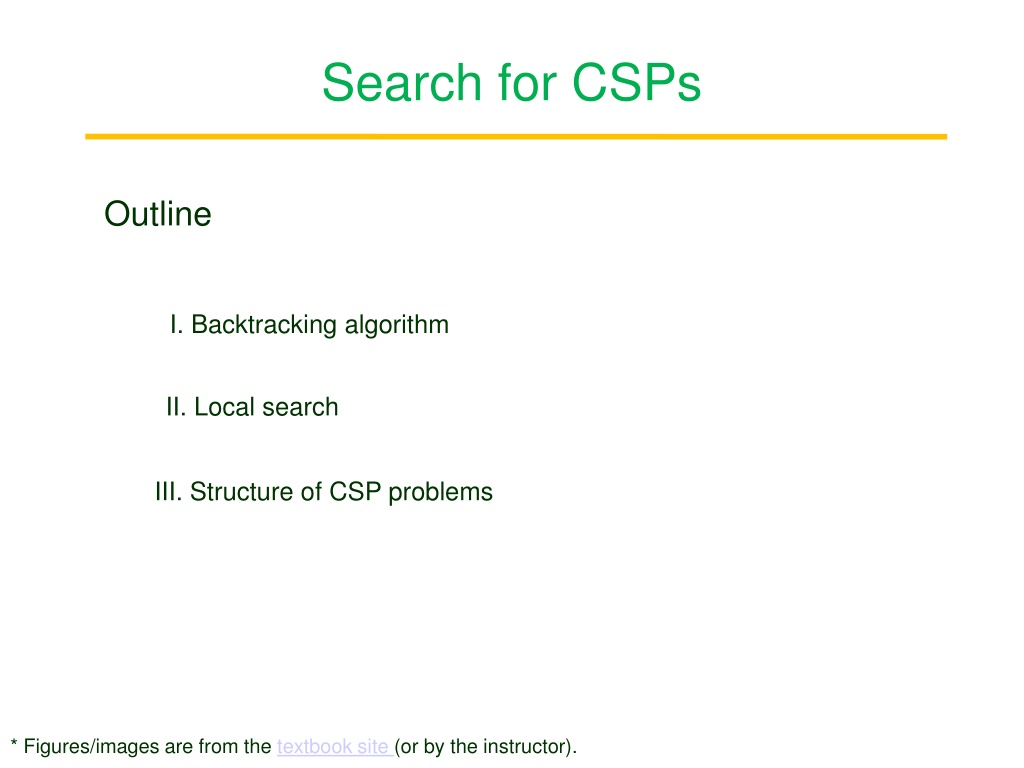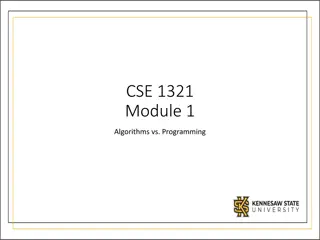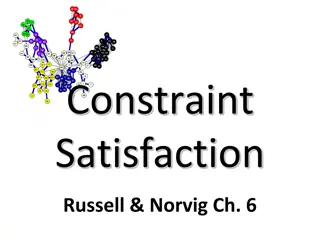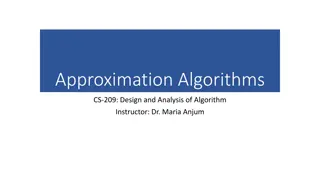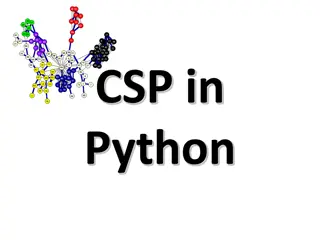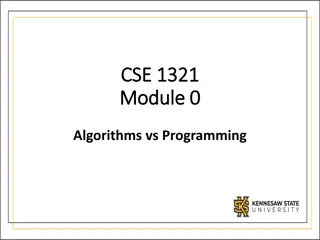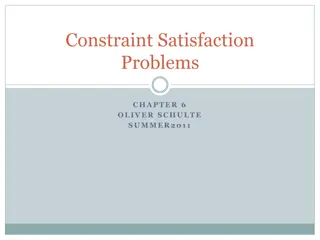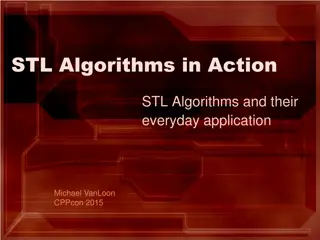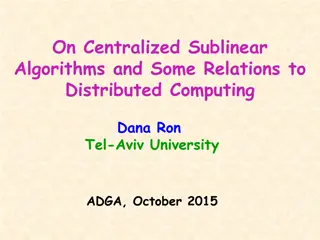Overview of CSP Algorithms and Techniques
Explore the key concepts of Constraint Satisfaction Problems (CSPs) including backtracking search, local search, and the structure of CSP problems. Learn about important algorithms such as depth-limited search and heuristics like Minimum Remaining Values (MRV) and Degree Heuristics. Discover the commutativity of CSPs and the implementation of backtracking algorithms to solve CSPs efficiently.
Download Presentation

Please find below an Image/Link to download the presentation.
The content on the website is provided AS IS for your information and personal use only. It may not be sold, licensed, or shared on other websites without obtaining consent from the author.If you encounter any issues during the download, it is possible that the publisher has removed the file from their server.
You are allowed to download the files provided on this website for personal or commercial use, subject to the condition that they are used lawfully. All files are the property of their respective owners.
The content on the website is provided AS IS for your information and personal use only. It may not be sold, licensed, or shared on other websites without obtaining consent from the author.
E N D
Presentation Transcript
Search for CSPs Outline I. Backtracking algorithm II. Local search III. Structure of CSP problems * Figures/images are from the textbook site (or by the instructor).
I. Backtracking Search Constraint propagation often ends with partial solutions. Backtracking search can be employed to extend them to full solutions. Solve a CSP using depth-limited search. ? variables of domain size ? start ??= ?? ?1= ?1 ?1= ?? ?2= ?1 (any value can be assigned to any variable at depth 1) ?? ? 1 ? #leaves = ?! ?? But #assignments =??. How to get back to ???
Commutativity of CSP A problem is commutative if the order of application of any given set of actions does not matter. assignments in a CSP No difference between Step 1: NSW=red Step 2: SA = blue Step 1: SA = blue Step 2: NSW=red and Need only consider a single variable at each node. At the root choose between SA = blue, SA=red, and SA=green but not between SA = blue and NSW=red
Backtracking Algorithm Repeatedly chooses an unassigned variable ??. Tries all values ?? ?? (its domain). Add ??= ?? to the partial solution (after consistency checking). NT SA Q NSW WA V T Try to extend it into a solution via a recursive call (in which another unassigned variable will be considered)
Backtracking // arc- or path-consistency, etc. // forward checking, etc. returns // reduced domains.
Order of Variables var SELECT-UNASSIGNED-VARIABLE(csp,assignment) In what order should we choose the variables? Static order: ?1,?2, ? Neither is optimal! Random order: ?1,?2, ? NT SANSW V Q WA T It makes more sense to assign ?? = ???? than assigning Q.
MRV and Degree Heuristics Minimum-remaining-values (MRV): Choose the variable with the fewest legal values. A.k.a. most constrained variable or fail first heuristic If some variable has no legal values left, select it! Performs better than a random or static ordering. Use the degree heuristic as a tie-breaker or at the start. deg(SA) = 5 Others have degrees 3. Color SA first.
Least Constraining Value For the selected variable, choose its value that rules out the fewest choices for the neighboring variables in the constraint graph. green Which color to assign to Q next? red If blue, then SA would have no color left. Choose red. The least-constraining-value heuristic tries to create the maximum room for subsequent variable assignments.
Variable vs. Value Selections Variable order: fail-first. Fewer successful assignments to backtrack over. Value order: fail-last. Only one solution needed. It makes sense to look for the most likely values first.
Forward Checking Inference: Every new variable assignment opens the door for new domain reductions on neighboring variables. Assignment ? = ? ? unassigned unassigned ? For every unassigned ? connected to ? , delete any value from ? s domain that is inconsistent with ?. assigned
Backtracking with Forward Checking WA=red Deletes red for NT and SA. Q=green Deletes green for NT, SA , and NSW. NT & SA each has a single value. ?=blue SA has no legal value. Delete {WA = red,Q = green,? = blue}. Start backtracking.
Combining MRV and FC Heuristics Search becomes more effective when they are combined. NT and SA are constrained by the assignment WA=red. Deal with them first according to MRV. Combination of MRV and FC can solve the 1000-queen problem.
II. Local Search Every state corresponds to a complete assignment. Search changes the value of one variable at a time. Min-conflicts heuristic: Start with a complete assignment. Randomly choose a conflicted variable. Select the value that results in the least conflicts with other variables.
Applying Min-conflicts to 8-Queen Variable set: ? = {?1,?2, ,?8} ?8out of the set {?4,?8} of conflicted variables by a random choice. ??:the row number of the queen placed in the ?th column. The 8th queen in row 3 or 6 would violate only one constraint. Move the queen to, say, row 3. 2 conflicts if ?8= 7 ?8= 8
8- and ?-Queen problems Solution ?6out of {?6,?8}. Reassignment: ?6= 8.
Local Search: ?-Queen and Beyond Run time of min-conflicts on ?-queen is roughly independent of ?. 106-queen problems are solved in an average of 50 steps (after the initial assignment). Ease of solving ?-queen due to dense distribution of solutions throughout the state space. Min-conflicts also effective on hard problems such as observation scheduling for the Hubble Space Telescope. Local search is applicable in an online setting (e.g., repairing the scheduling of an airline s weekly activities in the advent of bad weather).
III. The Structure of CSP Problems Independent subproblems Connected components in the constraint graph. Each subproblem can be solved independently. ? variables domain size ? Total work ?(??) without problem decomposition. ?/? subproblems, each requiring ?(??) ? variables for each subproblem Total work ?(???/?) Linear in ?.
Tree-Structured CSPs ?(??2) Constraint graph is a tree. Solution: Generate a topological order of the variables (pick any variable as the root). ?,?,?,?,?,? root ?(?) Visit variables in the reverse order. ?,?,?,?,?,? ?(?) At each visited vertex ?, make every incoming edge ?,? arc-consistent (i.e., ? is arc-consistent w.r.t. ?) by reducing the domain of ?. ?(?2) Finally, visit variables in the topological order again to assign values sequentially. ?,?,?,?,?,? ?(?)
Cutset Conditioning Reduce a constraint graph to a tree (or a forest) by assigning values to some variables. Assign a value to SA and remove the node. 1. Choose a subset ? ? of variables whose removals reduce the constraint graph to a tree (or a forest). 2. For every consistent assignment ? to variables in ?: remove from the domain of every ? ? S all values that are inconsistent with ?. return the solution to the reduced CSP (if exists) along with ?.
Tree Decomposition Transform the constraint graph into a tree where each node consists of a set of variables such that All variables & constraints are represented. Every variable ? must appear in at least one tree node ?. Two variables ?,? sharing a constraint must appear together in at least one node ?. If ? appears in two nodes ?1 and ?2, it must appear in every node on the path connecting ?1 and ?2. A variable must have the same value everywhere it appears. ?1 ?2
Solution After Tree Decomposition Use the CSP tree solver to move from one tree node to the next in some topological order. At each tree node, solve the CSP subproblem represented at that node.
